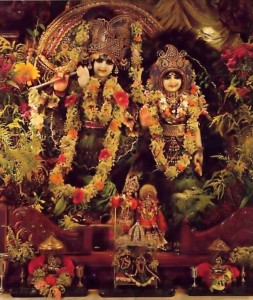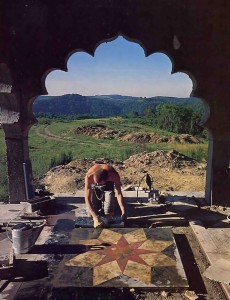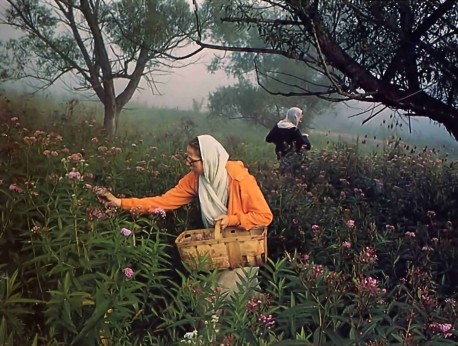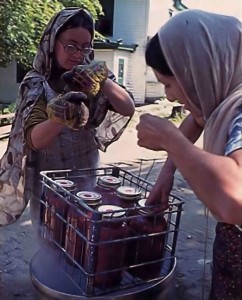
“Human prosperity flourishes by natural gifts, and not by gigantic industrial enterprises, “says His Divine Grace A.C. Bhaktivedanta Swami Prabhupada, who has founded many Krishna-conscious farming communities all over the world. “The gigantic industrial enterprises are products of a godless civilization, and they cause the destruction of the noble aims of human life…. What we need, therefore, is to be obedient to the laws of the Lord and achieve the perfection of human life by devotional service to Him. “Here’s a look at two ‘ ISKCON farms in action.

Krishna’s Village In West Virginia
by Taru dasa

About the last thing anyone would expect to find tucked away in the rolling hills of West Virginia is a community of shaven-headed, saffron-robed Hare Krishna devotees. Yet, about ten miles south of Wheeling, near Route 250, just such a community is flourishing.
Begun in 1968, New Vrindaban embodies the ancient way of life that His Divine Grace A.C. Bhaktivedanta Swami Prabhupada calls “simple living and high thinking.” In 1966, when Srila Prabhupada founded the International Society for Krishna Consciousness in New York City, he stated that one of ISKCON’s primary purposes would be “to erect for the members and for society at large a holy place of transcendental pastimes dedicated to the Supreme Personality of Godhead, Krishna.” Just two years later Kirtanananda Swami, one of Prabhupada’s original disciples, came to West Virginia to carry out this mission.
New Vrindaban began as a 133-acre, inaccessible hill farm with one rundown shack, but in nine short years it has grown to more than one thousand acres with dozens of houses, barns, temples, and workshops spread over six well-developed farms. The community even has its own monthly magazine, The Brijbasi Spirit. Yet with all this economic growth the residents have never strayed from Srila Prabhupada’s original instructions on the nature of New Vrindaban: “The Vrindaban conception is that of a transcendental village without the botherations of the modern industrial atmosphere. In Krishna’s Vrindaban the people can fully depend on nature’s beauty and the cows, and this New Vrindaban should be such an ideal village—where the residents will have simple living and high thinking.” So the aim of New Vrindaban is not to provide a comfortable material situation for those who live there, but rather to establish a transcendental land where the atmosphere automatically reminds everyone of Krishna.
Kirtanananda Swami, New Vrindaban’s director and a former history instructor at Columbia University, points out how important it is that the devotees see Krishna as the center of all they do:

“The most successful communities throughout history have tended to be those that were strongly religious—those that could unify on the common worship of God. And obviously, when the concept of God is most agreed upon, the community will be most united and harmonious. All our activities center upon Krishna and His eternal consort Radharani, who reside here in Their Deity forms of Sri Sri Radha-Vrndavana Candra [Vrndavana Candra means “Krishna, the moonlike Lord of Vrndavana”]. We assemble in the temple every morning and evening for worship, and this gives meaning and direction to all our diverse activities. In other words, this temple is our spiritual center. We come early in the morning and see Krishna and Radharani and glorify Them by chanting Hare Krishna, Hare Krishna, Krishna Krishna, Hare Hare/ Hare Rama, Hare Rama, Rama Rama, Hare Hare. In this way our minds remain peaceful and fixed on Krishna all day.”

The 165 devotees live in several dormitories and small houses near the temple. While they eat and dress and live very simply, they accord the Deities, Sri Sri Radha-Vrndavana Candra, the most regal opulence. The temple floor and altar are made of marble that devotees cut and polished at the community marble shop. On the altar rests a beautifully carved teakwood Deity platform called a srngasana (complete with gold and silver decorations), and the Deities Themselves wear bejeweled silk garments and pearl necklaces. Although the devotees desire no opulence for themselves, they realize that nothing is too nice for Krishna. Krishna is the center of their lives, and simply by giving something nice to Krishna, they satisfy everyone—just as by pouring water on the root of a tree, one simultaneously nourishes all the leaves and branches.
Across from the temple we find a new four-story building called a dharmasala (roughly, dharmasala means “lodge”). The upper floor contains guest rooms, while the entire second floor serves as a prasada room, a room where the devotees eat. (Prasada is vegetarian food offered to Krishna with devotion.) The walls and floor of the prasada room are set in marble. Although it’s as big as a basketball court, during the recent festival on Krishna’s birthday it overflowed with devotees and guests. On the first floor of the dharmasala is a spacious kitchen area containing five large stoves, each big enough to hold a sixty-gallon pot. New Vrindaban boasts the best prasada in the world, with over seventy-five preparations cooked daily.
All the community’s early-morning activities are centered in these two buildings, the temple and the dharmasala. The devotees rise early—2:30 or 3:00 a.m.—and go to the temple for two hours of individual chanting of the Hare Krishna mantra, an arati celebration (which resembles the Christian mass), and classes on the Srimad-Bhagavatam (“The Beautiful Story of the Personality of Godhead”) and the Bhagavad-gita (“The Song of God”), two ancient Vedic texts that explain the science of Krishna consciousness. At 6:30 everyone goes to the dharmasala for breakfast. The rest of the day the devotees engage in a flurry of activities all around the farm.
Directly beside the dharmasala stands the old Bahulaban barn, now divided into two halves—one for woodwork (with table saws, routers, band saws, and the like) and the other for black-smithing, ironworking, and so forth. Also, the devotees plan to expand the operation into a foundry for casting ornamental metals and Deities.
Across the road we find a seemingly inexhaustible supply of firewood, neatly cut and stacked in cords. But surprisingly, the wood will last no more than half the winter. Woodcutting and land clearing are year-round jobs. Bahulaban farm alone has five large buildings, whose boilers need wood all through the winter. Fully sixty percent of New Vrindaban ‘s thousand acres is woodland, and all summer and winter devotees thin the forests to secure firewood and lumber.


About two blocks down the road from the dharmasala we find the gosala (“the cow shelter”), where Krishna’s cows live. New Vrindaban’s cow population has grown to 150, mostly Holsteins and also some Brown Swiss and Jerseys. From the very start, one of the community’s main purposes has been to demonstrate the humaneness and practicality of cow protection. Srila Prabhupada writes, “In New Vrindaban people should live an ideal spiritual life, completely depending upon agricultural produce and milk from the cows. If there are sufficient grains and milk, the whole economic problem is solved. However, we have to maintain the animals throughout their lives. We must not sell them to the slaughterhouses. Krishna, through His practical example, taught us to give all protection to the cows, and cow protection should be the main business of New Vrindaban.”

Cows graze all around the Bahulaban area. The gosala itself holds forty cows at a time for milking. “Last spring we were getting almost sixteen hundred pounds of milk a day,” Kirtanananda Swami explained. “And one cow hit just under 120 pounds per day for several months. From this ocean of milk we produce about six gallons of butter every day, most of which we turn into ghee [clarified butter] and use here or send to the Society’s restaurants. We consider ghee very important, because Srila Prabhupada has said that once people develop a taste for foods cooked in ghee, they will give up meat eating.
“When Krishna Himself appeared on this planet, He lived among the cowherds, and cows are very dear to Him,” says Kirtanananda Swami. “Consequently, Sri Krishna is celebrated as go-brahmana-hitaya ca, the protector of cows and brahmanas (saintly intellectuals]. In a God-conscious, Vedic civilization the cow is fundamental both economically and spiritually, and by protecting the cows and the brahmanas, people are guaranteed both material and spiritual success. Conversely, when people slaughter the cow and disrespect the brahmanas, their so-called civilization becomes hellish.
“Naturally, cow protection includes bull protection. The bull is our father and the symbol of religion. At present a few boys are working the oxen and hauling wood, plowing fields, and cutting hay. Of course, we do have tractors, but we want to develop skill working the oxen. They are our future.”
Beside the gosala stand two steel-and-glass Harvestore silos, the first twenty by fifty feet and the second twenty by thirty-five feet. The larger silo holds hay, and the smaller one holds ground ear corn. A third silo, erected this fall, holds three hundred tons of corn silage.
“This year Krishna has given us very good weather,” Kirtanananda Swami says, “and the harvest has been wonderful. We’re bringing in practically twice as much as usual, and it looks as though for the first time in our history we’ll have a surplus for sale. We generally get three good cuttings of hay, but this year we may get four. In addition, we’re constantly planting new crops. We planted twenty-five new acres of alfalfa this year, and we’ll seed another twenty-five acres with red clover in the spring. Both improve the quality of the hay. Offhand I’d say that each year we cut about 125 acres of meadowland and bring in about ten thousand bales of hay.”
The devotees also grow grains for human consumption—buckwheat and wheat, for instance. This year they are also growing mung beans for dahl (soup). The community’s mill grinds the wheat into flour for chapatis (flat, puffed bread patties) during the week and buckwheat pancakes on Sundays. Of course, the bulk of the grain harvest goes to the cows and comes to the devotees as milk, cheese, and butter.
Vegetables grow luxuriantly in the main garden, located next to Radha Vrndavana Candra’s temple. Generally, the vegetable garden supplies the community all summer and part of the winter, and this year the crop was better than ever.
Although most of the community’s activities take place at Bahulaban, the main construction is going on at another farm about two miles away. At this hundred-acre farm (called Guruban, in honor of Srila Prabhupada) we find what a major newpaper calls “a masterwork of design and painstaking effort.” Now nearly completed, “Srila Prabhupada’s Palace” sits atop the highest hill for miles around and has a view that is truly celestial. In fact, the Palace itself appears to have descended from another world. Its concrete dome, intricately cut marble floors, hand-molded concrete work, and portico entrances recall the temples of ancient India. Actually, the Palace beautifully combines Eastern and Western styles, thanks to the sincere dedication of Bhagavatananda dasa, a seven-year devotee who designed and helped build the entire structure. The main dome is flanked by two smaller domes, and the facing of the building is of Italian marble. Around the perimeter we find a walkway enclosed with lotus arches. The walkway is a checkerboard of red and green marble, and the columns have facings of geometrically carved marble. Throughout the interior are finely sculptured doorjams, windowsills, cornices, railings, and so on.
Inside the Palace’s main room, Italian white Cremo marble covers the walls above a finely carved wainscot. Kirtanananda Swami points out that the devotees are also fashioning stained-glass windows and crystal chandeliers. Large paintings of Krishna-conscious spiritual masters throughout history will complete the temple.
Kirtanananda Swami says that the major event in New Vrindaban’s history has been the building of the Palace. “Originally we were planning Govindaji Temple to be our first major construction effort. But after a while I began to think this was not exactly right. The sastras [revealed scriptures] say that one has to approach Krishna through the spiritual master. So we decided first of all to construct a residence for Srila Prabhupada. Actually, we can see that everything that has happened has been simply by Krishna’s plan. After all, before this none of us had ever designed a building or worked with crystal chandeliers or marble or anything like that. But gradually, Krishna has revealed these skills, up to the point that now we have become convinced that whatever we think of we can actually execute. Simply because we wanted to give something wonderful to Srila Prabhupada, Krishna has brought all of this here. It has certainly not developed from our skill.
“We hope to attract many people to the Palace,” Kirtanananda Swami says. “We don’t shun publicity—our mission is to spread Krishna consciousness. The Palace is devotion; it’s Krishna consciousness in action. People may come here simply because they are attracted by a beautiful building, but when they come we can instruct them on the importance of accepting the guidance of a bona fide spiritual master.”
Connected to the Palace and Guruban is Madhuban, which consists of eighty-eight acres of pine trees and corn and wheat fields. The center of Madhuban is Lord Jagannatha’s temple, and apart from Jagannatha Puri in India, the Jagannatha Deities here are the largest in the world. They are five feet tall and are carved out of an old elm that once fell down on the Vrindaban Road.
Behind the main house at Madhuban are a number of individual residences shaped like aboriginal huts and composed of a mixture of cement and clay. These are called “Prabhupada houses,” because Srila Prabhupada himself designed them back in 1969. They take only a couple of days to build, and they provide an economical dwelling for devotees who like more privacy.
But anyone looking for a really quiet, meditative atmosphere will discover that the original Vrindaban Farm is the best. Though visible from across the valley at Madhuban, the old Vrindaban farm is virtually inaccessible. Its 133 acres connect to Madhuban along a peaked ravine that’s impossible to climb during winter. The only practical access to Vrindaban is a muddy two-mile road starting at Bahulaban. Vrindaban Farm is the place where Srila Prabhupada first visited in 1969, and now it is the home of thirty-six brahmacaris [celibate students] and the Deities Sri Sri Radha-Vrndavana-natha. The devotees have converted the 150-year-old farmhouse into a small temple to shelter the Deities. And nearby are a number of individual dwellings, including two A-frames and a geodesic dome.
“Only two or three boys stay at Vrindaban Farm during the day,” explains Kirtanananda Swami. “Everyone else leaves to work at Bahulaban or the Palace. Vrindaban is more like a retreat, and its atmosphere is one of special seclusion. It is not our goal, however, to become recluses. Srila Prabhupada has warned us that it’s not a good idea for a conditioned soul to try to retire from his normal activities. Our main concern here is rendering service to Krishna and in that way advancing in Krishna consciousness.”
On a ridge to the west of Vrindaban Farm lies a 208-acre tract of land called Nandagrama. This farm is accessible by a half-mile gravel road. Like the Vrindaban farm, Nandagrama is very isolated. It consists mostly of corn and alfalfa fields, magnificent hardwood forests, and pastureland for about forty calves and heifers. The creeks running between the ridges have many waterfalls where the devotees sometimes bathe during the summer. Also, the Gurukula school is located at Nandagrama, and three teachers and fourteen little brahmacaris now live there year-round. The boys spend much of their recreation time playing with the calves and heifers.
Kirtanananda Swami has this advice for new communities: “Don’t try to start one without Krishna at the center. We never would have lasted through the first winter without faith in the instructions of Srila Prabhupada and a lot of chanting of the Hare Krishna mantra. In the beginning, real community living isn’t all milk and honey, although there is plenty of both.
“Here at New Vrindaban we hope to show that regardless of occupation or skill, everyone can serve Krishna by applying his energy to help us establish a transcendental village devoted to Him. People are always coming here with new skills, new devotion, and new help. The only requirement for living here is the desire to serve Krishna. Of course, one has to be willing to purify his life and give up sense gratification, especially gambling, illicit sex, intoxication, and meat eating. By chanting Hare Krishna we can come to realize that all of Krishna’s creation is holy and that Krishna deserves our eternal service. And through this service we can ultimately attain the sweetest relationship and the goal of life—deep love of Krishna.”
The son of a Baptist minister, Kirtanananda Swami was born in 1937 and came to the Krishna consciousness movement in 1966. In 1967, at the famed Radha-Damodara temple in India’s Vrndavana, His Divine Grace A.C. Bhaktivedanta Swami Prabhupada conferred on him the sannyasa, or renounced, order (and hence the title “swami”), a first in ISKCON’s history. Under Srila Prabhupada’s guidance, he started New Vrindaban in 1968.

Can I get more information about ancient agriculture